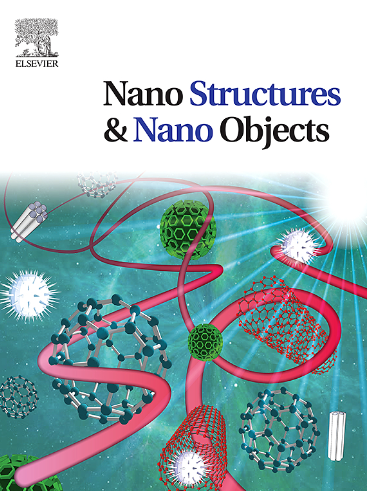Structural and electrochemical impact of Co-doping in BiVO4 nanostructured supercapacitors
IF 5.45
Q1 Physics and Astronomy
引用次数: 0
Abstract
In this work, we studied the effect of Co-doping in BiVO4 nanostructures for improved supercapacitor performance. A one-pot hydrothermal method was employed to synthesize Co-doped BiVO4 nanostructures at varying dopant concentrations (5 % and 10 %) and to investigate their morphologies and structural characteristics using various analytical techniques. XRD patterns revealed the presence of monoclinic and tetragonal phases, resulting from the synergistic effects of Co-doping and percentage tuning during the synthesis process. FTIR spectra identified the metal oxygen vibrational modes. UV-Vis analysis revealed tunable optical band gaps, indicating improved electronic properties resulting from Co-doping. An electrochemical study, including cyclic voltammetry (CV) and Galvanostatic charge-discharge (GCD), of the BiVO4 material revealed an impressive enhancement in supercapacitor performance following Co-doping. The 10 % Co-doped BiVO4 electrode exhibited a specific capacitance (Cs) of 211.00 F/g under a 10 mV/s CV scan rate, which significantly outperformed that of the 5 % Co-doped (170.2 F/g) and undoped (34.00 F/g) counterparts. Although GCD investigations revealed that 5 % Co-doping yielded the longest discharge times at low current densities (∼70 s for 5 % Co compared to ∼47 s for 10 % Co at 0.5 mA/g), both doped samples significantly outperformed the undoped BiVO4. The results show the significant impact of Co-doping on the structural and electrochemical properties of BiVO4, establishing Co-doped BiVO4 as an excellent candidate for energy storage devices.
共掺杂对BiVO4纳米结构超级电容器结构和电化学的影响
在这项工作中,我们研究了在BiVO4纳米结构中共掺杂对提高超级电容器性能的影响。采用一锅水热法合成了不同掺杂浓度(5 %和10 %)的共掺杂BiVO4纳米结构,并利用各种分析技术研究了它们的形貌和结构特征。XRD图谱显示,由于共掺杂和合成过程中百分比调整的协同作用,存在单斜相和四方相。FTIR光谱鉴定了金属氧的振动模式。紫外可见分析显示可调谐的光学带隙,表明共掺杂改善了电子性能。一项包括循环伏安法(CV)和恒流充放电(GCD)在内的电化学研究显示,共掺杂后,BiVO4材料的超级电容器性能得到了显著提高。10 %共掺杂BiVO4电极在10 mV/s CV扫描速率下的比电容(Cs)为211.00 F/g,显著优于5 %共掺杂(170.2 F/g)和未掺杂(34.00 F/g)的电极。虽然GCD研究表明,5 % Co掺杂在低电流密度下产生最长的放电时间(5 % Co在0.5 mA/g下为~ 70 s,而10 % Co在0.5 mA/g下为~ 47 s),但两种掺杂样品的性能都明显优于未掺杂的BiVO4。结果表明,共掺杂对BiVO4的结构和电化学性能产生了显著影响,确立了共掺杂BiVO4作为储能器件的良好候选材料。
本文章由计算机程序翻译,如有差异,请以英文原文为准。
求助全文
约1分钟内获得全文
求助全文
来源期刊

Nano-Structures & Nano-Objects
Physics and Astronomy-Condensed Matter Physics
CiteScore
9.20
自引率
0.00%
发文量
60
审稿时长
22 days
期刊介绍:
Nano-Structures & Nano-Objects is a new journal devoted to all aspects of the synthesis and the properties of this new flourishing domain. The journal is devoted to novel architectures at the nano-level with an emphasis on new synthesis and characterization methods. The journal is focused on the objects rather than on their applications. However, the research for new applications of original nano-structures & nano-objects in various fields such as nano-electronics, energy conversion, catalysis, drug delivery and nano-medicine is also welcome. The scope of Nano-Structures & Nano-Objects involves: -Metal and alloy nanoparticles with complex nanostructures such as shape control, core-shell and dumbells -Oxide nanoparticles and nanostructures, with complex oxide/metal, oxide/surface and oxide /organic interfaces -Inorganic semi-conducting nanoparticles (quantum dots) with an emphasis on new phases, structures, shapes and complexity -Nanostructures involving molecular inorganic species such as nanoparticles of coordination compounds, molecular magnets, spin transition nanoparticles etc. or organic nano-objects, in particular for molecular electronics -Nanostructured materials such as nano-MOFs and nano-zeolites -Hetero-junctions between molecules and nano-objects, between different nano-objects & nanostructures or between nano-objects & nanostructures and surfaces -Methods of characterization specific of the nano size or adapted for the nano size such as X-ray and neutron scattering, light scattering, NMR, Raman, Plasmonics, near field microscopies, various TEM and SEM techniques, magnetic studies, etc .
 求助内容:
求助内容: 应助结果提醒方式:
应助结果提醒方式:


